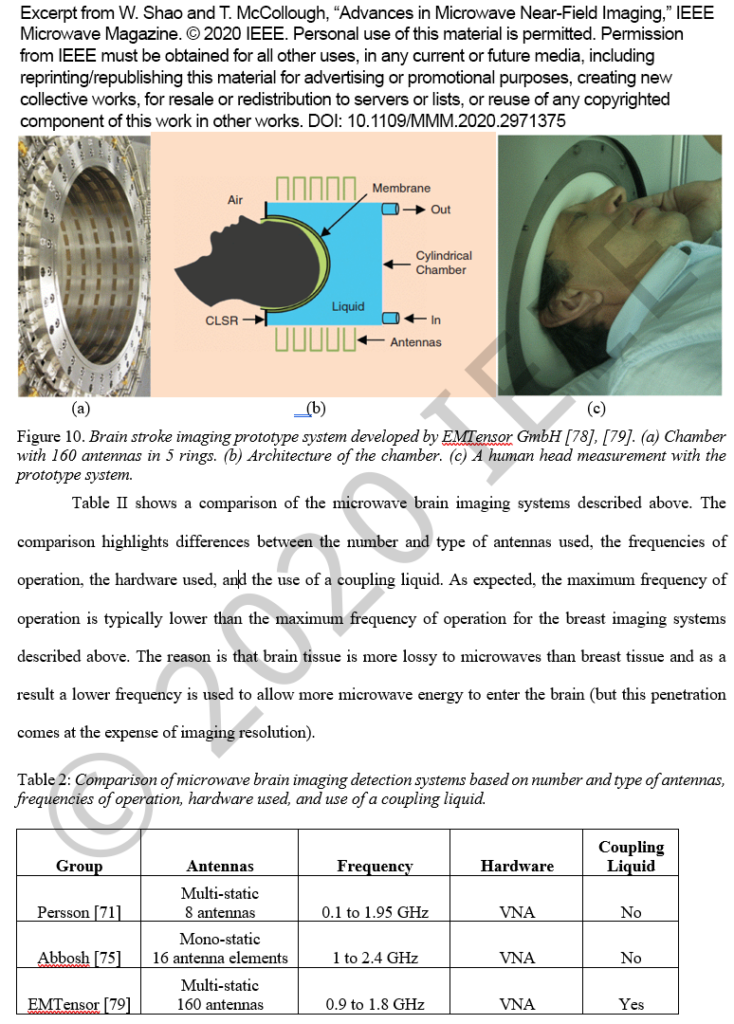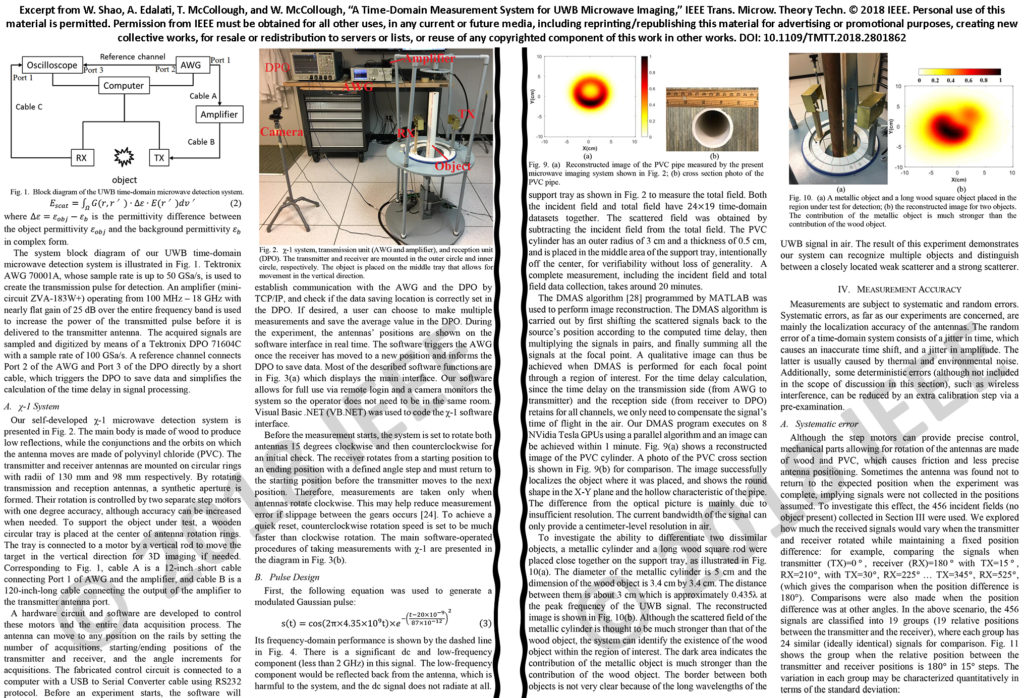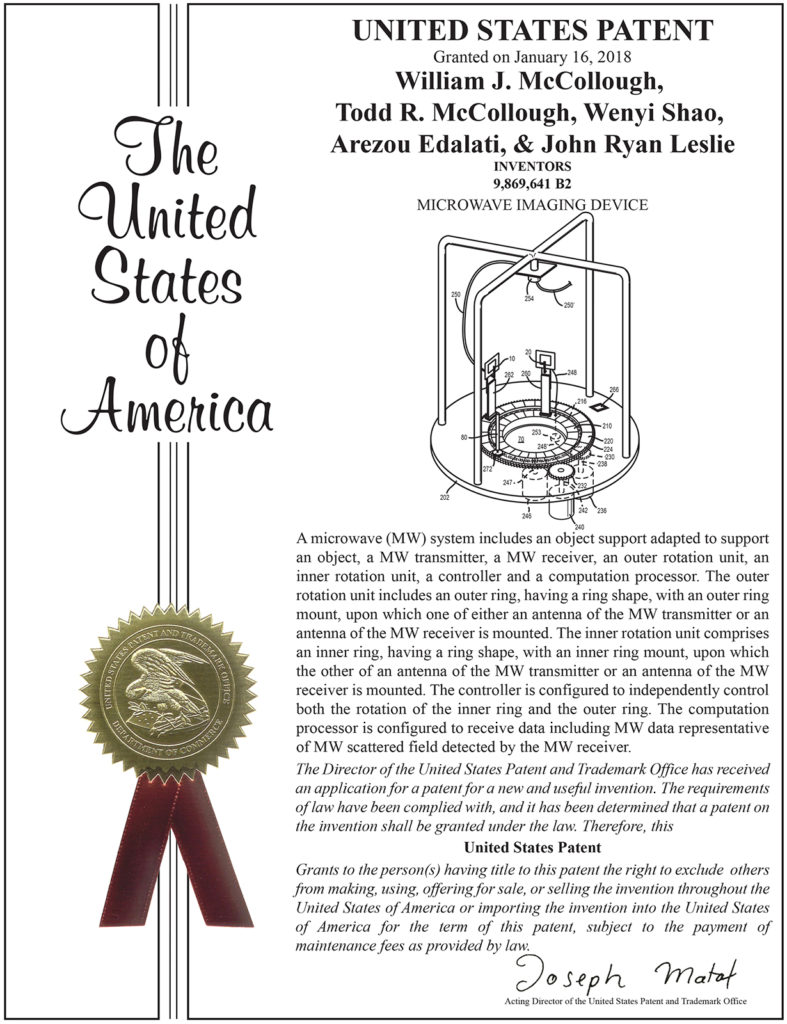The post Advances in Microwave Near-Field Imaging: Publication in IEEE Microwave Magazine appeared first on Todd McCollough's Website.
]]>Based on a thorough review of the systems, the paper also offers an outlook of using microwave imaging in the future. Microwave imaging for medical applications has attracted significant interest which is expected to continue due to technical developments and improvements in hardware manufacturing and software. Vector network analyzers and oscilloscopes that have longed been used in experimental systems are starting to become replaced by more compact and cost effective instruments which will help with future commercial products. Decreases in system cost and size is to be expected moving forward. It is believed that microwave imaging techniques will be expanded to additional clinical applications and clinical trials will help lead the way towards use in patient care utilizing this technology.
I have included an excerpt from the accepted version of the paper below. DOI: https://doi.org/10.1109/MMM.2020.2971375 © 2020 IEEE. Personal use of this material is permitted. Permission from IEEE must be obtained for all other uses, in any current or future media, including reprinting/republishing this material for advertising or promotional purposes, creating new collective works, for resale or redistribution to servers or lists, or reuse of any copyrighted component of this work in other works.

Table 2 in the paper offers a comparison of three microwave brain-imaging detection systems. It is noteworthy that the frequency used by the three groups is typically lower than that found for comparable breast-imaging systems. This is because brain tissue is more lossy to microwaves than breast tissue and thus a lower frequency allows for more energy to enter the brain. One of the microwave brain-imaging detection systems is developed by EMTensor and detects strokes. This system was previously exhibited on the floor of the Radiological Society of North America’s (RSNA) 104th Scientific Assembly and Annual Meeting at McCormick Place in Chicago, IL, in 2018.
The post Advances in Microwave Near-Field Imaging: Publication in IEEE Microwave Magazine appeared first on Todd McCollough's Website.
]]>The post A time-domain measurement system for UWB microwave imaging: publication in IEEE MTT appeared first on Todd McCollough's Website.
]]>I have included an excerpt from the accepted version of the paper below. DOI: https://doi.org/10.1109/TMTT.2018.2801862 © 2018 IEEE. Personal use of this material is permitted. Permission from IEEE must be obtained for all other uses, in any current or future media, including reprinting/republishing this material for advertising or promotional purposes, creating new collective works, for resale or redistribution to servers or lists, or reuse of any copyrighted component of this work in other works.
Figure 2 in the paper shows the system as was set up at Ellumen Inc. along with a PVC cylinder placed in the middle tray. A reconstructed image from data collected using the setup in Figure 2 using the delay multiply and sum (DMAS) imaging algorithm is shown in Figure 9. In Figure 10(a) the object was changed to a metallic object and a long wood square object both placed in the middle tray. A reconstructed image produced using DMAS is shown in Figure 10(b). Also note that the DMAS algorithm was programmed on eight nVidia Tesla GPUs which allowed images to be produced in under 1 minute. A comparison between the time domain system and frequency domain system was performed in the paper but is not included in the above excerpt. This analysis showed that both methods of data collection can allow for accurate reconstructed images to be obtained. The software to control the data collection was also updated as presented in this paper so that it takes 20 minutes to complete both incident and total field data collections. I encourage you to download and read the full “A Time-Domain Measurement System for UWB Microwave Imaging” paper from IEEE for full details and analysis.
The post A time-domain measurement system for UWB microwave imaging: publication in IEEE MTT appeared first on Todd McCollough's Website.
]]>The post Microwave Imaging Device Patent Named Co-Inventor on Assigned to Ellumen Inc. appeared first on Todd McCollough's Website.
]]>The “Microwave Imaging Device” patent resulted from wanting an automatic way to acquire microwave imaging data pertaining to some object and/or body part from both a movable transmitting and receiving antenna. In addition, there was desire to be able to collect not just 2D data but also 3D data and also acquire the surface information of what was placed inside the scanner. To accomplish this, a system was built that: 1) contained an object support to hold an object on, 2) contained a transmitter antenna, 3) contained a receiver antenna, 4) had both an inner and outer ring where either the transmitter or receiver was mounted on, 5) contained a controller to independently rotate both the inner and outer ring, 6) contained a computation processor to receive the collected data, and in one embodiment 7) contained a controller to move the object support up and down, and 8) contained an object surface position sensor mounted to either the inner or outer ring to collect the surface of the object. It is important to note that the inner and outer ring are concentric to each other but have different radii. In some embodiments, gears, pinions, and motors are used to help rotate the inner and outer rings, while a feedback monitor can determine if any potential mismatch in positioning occurs. The system further allows for the object surface position data to be used as a seed in the reconstruction of an image represented in dielectric values. In one embodiment, stored data of a prior image reconstruction that closely matches data of the object is used in combination with surface position data as a seed in the reconstruction. The patent also allows for the transmitter and receiver antenna to be mounted in such a way that they can radially translate to and from the center of the device. In addition, the patent covers some aspects of the controller and its module including positions to move both the transmitter and receiver antenna to, the names and locations of the collected data for storage, any necessary instrument parameters, and a calibration of the initial positions of the transmitter and receiver antenna.
The Celadon Research Division of Ellumen Inc. built a prototype of the robotic microwave imaging device as described in the patent that communicates with laboratory instruments (arbitrary waveform generator, oscilloscope, and vector network analyzer) and an infrared sensor and acquires data at different positions for the transmitting and receiving antenna and sensor. I helped program instrument commands to talk to the laboratory instruments using Virtual Instrument Software Architecture (VISA) to automatically acquire data. I collaborated on development of the graphical user interface (GUI) using VB.NET, MATLAB, and a dynamic-link library (DLL). The device can collect data in both the time and frequency domains and be operated remotely with monitoring by a camera. I helped collect data and programmed code to process the data including quickly loading in many data sets, plotting the data, performing analysis, and performing surface reconstruction. I also helped program and generate image reconstruction results from the data collected by the device. The Celadon Research Division of Ellumen Inc., presented a discussion of the device and imaging results in the journal publication IEEE Transactions on Microwave Theory and Techniques and at the IEEE AP-S Symposium on Antennas and Propagation and USNC-URSI Radio Science Meeting in San Diego, CA, in July 2017. See the paper titled “A Phase Confocal Method for Near-Field Microwave Imaging” and the paper of the poster presentation titled “Experimental Microwave Near-field Detection with Moveable Antennas” for some additional details. I was a co-author on the published paper and helped participate in the presentation. A few photos from the conference in San Diego were previously published in the post titled “IEEE AP-S Symposium on Antennas and Propagation and USNC-URSI Radio Science Meeting in San Diego, CA, in July 2017.”
It is exciting to work on new technology and devices that can have a real impact on the health of patients. Below is a patent certificate that was created to celebrate the accomplishment of having the patent granted.
The post Microwave Imaging Device Patent Named Co-Inventor on Assigned to Ellumen Inc. appeared first on Todd McCollough's Website.
]]>
